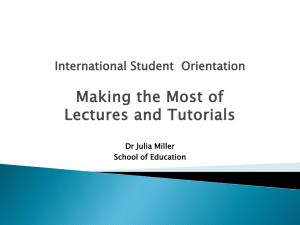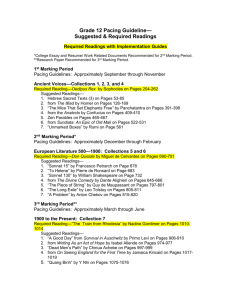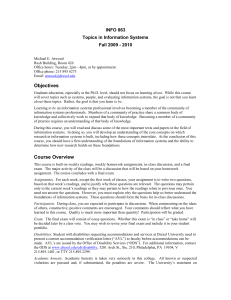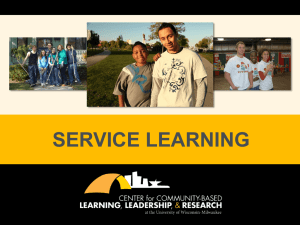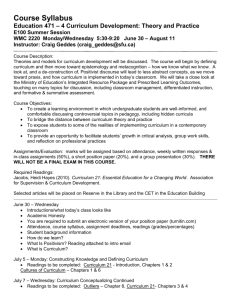UWM AIS 105-001(32336) Anishinaabe Ethnobotany: Plants in
advertisement
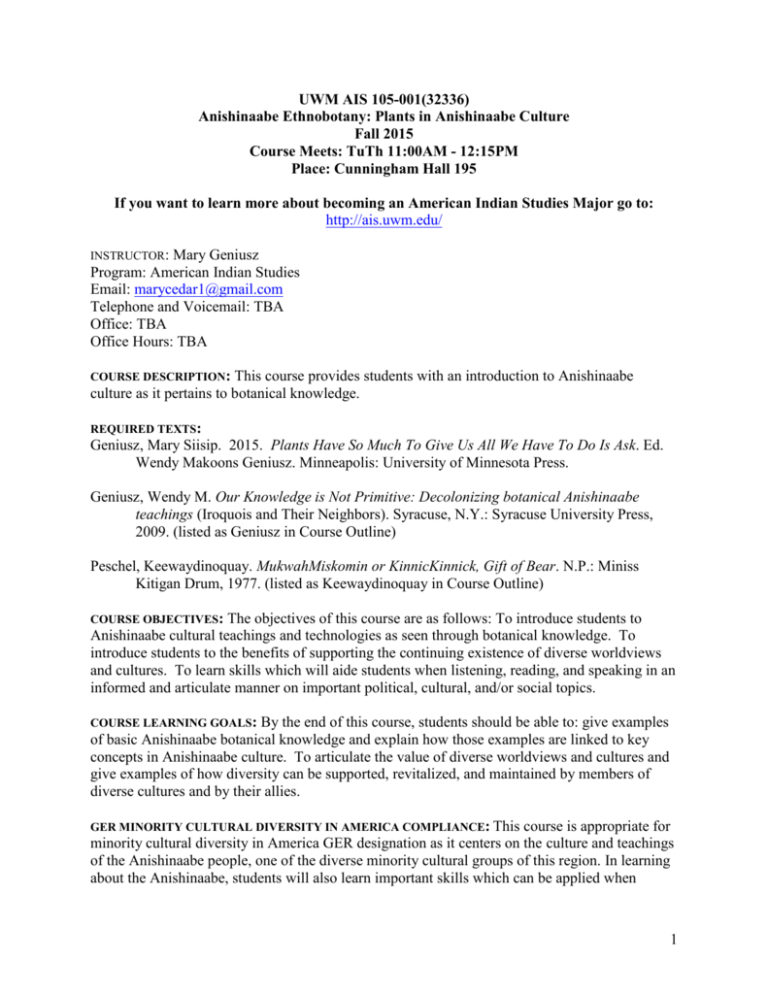
UWM AIS 105-001(32336) Anishinaabe Ethnobotany: Plants in Anishinaabe Culture Fall 2015 Course Meets: TuTh 11:00AM - 12:15PM Place: Cunningham Hall 195 If you want to learn more about becoming an American Indian Studies Major go to: http://ais.uwm.edu/ INSTRUCTOR: Mary Geniusz Program: American Indian Studies Email: marycedar1@gmail.com Telephone and Voicemail: TBA Office: TBA Office Hours: TBA COURSE DESCRIPTION: This course provides students with an introduction to Anishinaabe culture as it pertains to botanical knowledge. REQUIRED TEXTS: Geniusz, Mary Siisip. 2015. Plants Have So Much To Give Us All We Have To Do Is Ask. Ed. Wendy Makoons Geniusz. Minneapolis: University of Minnesota Press. Geniusz, Wendy M. Our Knowledge is Not Primitive: Decolonizing botanical Anishinaabe teachings (Iroquois and Their Neighbors). Syracuse, N.Y.: Syracuse University Press, 2009. (listed as Geniusz in Course Outline) Peschel, Keewaydinoquay. MukwahMiskomin or KinnicKinnick, Gift of Bear. N.P.: Miniss Kitigan Drum, 1977. (listed as Keewaydinoquay in Course Outline) COURSE OBJECTIVES: The objectives of this course are as follows: To introduce students to Anishinaabe cultural teachings and technologies as seen through botanical knowledge. To introduce students to the benefits of supporting the continuing existence of diverse worldviews and cultures. To learn skills which will aide students when listening, reading, and speaking in an informed and articulate manner on important political, cultural, and/or social topics. COURSE LEARNING GOALS: By the end of this course, students should be able to: give examples of basic Anishinaabe botanical knowledge and explain how those examples are linked to key concepts in Anishinaabe culture. To articulate the value of diverse worldviews and cultures and give examples of how diversity can be supported, revitalized, and maintained by members of diverse cultures and by their allies. GER MINORITY CULTURAL DIVERSITY IN AMERICA COMPLIANCE: This course is appropriate for minority cultural diversity in America GER designation as it centers on the culture and teachings of the Anishinaabe people, one of the diverse minority cultural groups of this region. In learning about the Anishinaabe, students will also learn important skills which can be applied when 1 analyzing the meaning of race, class, gender, and culture in America. The learning goals associated with this requirement is that students “understand and analyze the perspectives, world views, methodologies, and philosophic constructs that the Anishinaabe and others use to describe, explain, and evaluate their life experiences over time.” This goal will be assessed in class examinations. In addition, in our class discussions, students will be asked various questions (some of which are listed on the course outline) which will help them to “investigate critically the social, intellectual, and political structures that support oppression based on race, ethnicity, and other human differences.” An examination of the specific areas of weakness in students’ short answer essays on examinations will point to the topics that need to be communicated better or further reinforced. UW-SYSTEM SHARED LEARNING GOALS: The material and examinations in this course address the University of Wisconsin System Shared Learning Goals of “Intercultural Knowledge and Competence” and “Effective Communication Skills including reading, writing, and information literacy.” Both of these learning goals are defined here for reference: Intercultural knowledge and competence including the ability to interact and work with people from diverse backgrounds and cultures; to lead or contribute support to those who lead; and to empathize with and understand those who are different than they are. Effective Communication Skills including listening, speaking, reading, writing, and information literacy. INSTRUCTIONAL STRATEGIES: In this class we will use a variety of instructional strategies, including audio-visual exercises, class discussions, hands-on in class projects, and lectures. COURSE REQUIREMENTS: Students are expected to attend and participate in every class and complete all reading assignments before the class for which they are due. Students are also required to take all exams during scheduled times. COURSE GRADING POLICY: Final 1. 2. 3. 4. grades will be calculated as follows: Midterm Exam 20% Final Ethnobotany Display 30% Final Exam 30% Effort, Attendance, Participation, and Respect 20% Final Ethnobotany Display: Each student will be required to produce a display at the end of term to demonstrate practical application of concepts and techniques of working with natural materials to produce medicinals, foods, and various craft applications that they have learned during the semester. The display will be in class and/or open to rest of campus. Students will display their crafts, medicines and/or foods, and they will be expected to be able to articulate to the instructor and others present how the materials were produced. Students will be graded on effort extended to produce products as well as creativity, originality, and serviceability of items produced. Exams: There will be a midterm and a final exam for this class. They must be taken during the times assigned on the Course Outline. 2 Effort, Attendance, Participation, and Respect: This is an important part of your grade. You need to attend all class (2 sick days are allowed) and come to class prepared (including having completed readings. You also need to participate in each class, by asking and answering questions, listening attentively, and participating in all discussions and hands on activities. If students are repeatedly disrespectful of the professor, other students, any guests, or the Anishinaabeg, they will receive an automatic O for this component of their final grade. Attendance is part of your “effort, attendance, and participation” grade. If you are late to class, or leave class early, it will be counted as missing ½ of the class. Otherwise, this portion of your grade will be calculated as followed: A (4) Student attended all classes (2 sick days are allowed), eagerly participated and was prepared for most classes. B (3) Student attended most class (missed more than 2), and eagerly participated and was prepared for many classes. C (2) Student did not attend most of the time, but when s/he did attend, s/he participated eagerly and was prepared. D (1) Student did not attend most of the time, and when s/he did attend, s/he only eagerly participated and was only prepared for some of the time. F (0) Student made no effort to attend or participate in class. ATTENDANCE POLICY: Attendance will be taken during all classes. It is not a separate grade, it makes up part of your Effort, Attendance, Participation, and Respect grade. See that section for more details. OTHER IMPORTANT INFORMATION FOR STUDENTS: Students with disabilities. Verification of disability, class standards, the policy on the use of alternate materials and test accommodations can be found at the following: http://www4.uwm.edu/sac/SACltr.pdf Religious observances. Policies concerning accommodations for absences due to religious observance can be found at http://www4.uwm.edu/secu/docs/other/S1.5.htm Students called to active military duty. Accommodations for absences due to call-up of reserves to active military duty can be found at the following sites: Students: http://www4.uwm.edu/current_students/military_call_up.cfm Incompletes. A notation of "incomplete" may be given in lieu of a final grade to a student who has carried a subject successfully until the end of a semester but who, because of illness or other unusual and substantiated cause beyond the student's control, has been unable to take or complete the final examination or to complete some limited amount of term work. http://www4.uwm.edu/secu/docs/other/S31.pdf Discriminatory conduct (such as sexual harassment). Discriminatory conduct will not be tolerated by the University. It poisons the work and learning environment of the University and 3 threatens the careers, educational experience, and well-being of students, faculty, and staff. Find UWM policy details here: http://www4.uwm.edu/secu/docs/other/S47.pdf Academic misconduct. Cheating on exams or plagiarism are violations of the academic honor code and carry severe sanctions, including failing a course or even suspension or dismissal from the University. http://www4.uwm.edu/acad_aff/policy/academicmisconduct.cfm Complaint procedures. Students may direct complaints to the head of the academic unit or department in which the complaint occurs. If the complaint allegedly violates a specific university policy, it may be directed to the head of the department or academic unit in which the complaint occurred or to the appropriate university office responsible for enforcing the policy. http://www4.uwm.edu/secu/docs/other/S49.7.htm Grade appeal procedures. A student may appeal a grade on the grounds that it is based on a capricious or arbitrary decision of the course instructor. Such an appeal shall follow the established procedures adopted by the department, college, or school in which the course resides or in the case of graduate students, the Graduate School. These procedures are available in writing from the respective department chairperson or the Academic Dean of the College/School. http://www4.uwm.edu/secu/docs/other/S28.htm Academic Advising: All L&S students have to declare and complete an academic major to graduate. If you have earned in excess of 45 credits and have not yet declared a major, you are encouraged to do so. If you either are interested in declaring a major (or certificate) in American Indian Studies or require academic advising in American Indian Studies, please visit the American Indian Studies web page at http://ais.uwm.edu/ for information on how to proceed. 4 COURSE OUTLINE: *NOTE: All readings are due on the first class of the week on which they are listed! Week 1: Introductions to: Course, Anishinaabe Plant Knowledge Explaining differences between material taught in: Plants and Philosophy vs. Plants and Culture Courses In Class: Lectures on Intro to course, Anishinaabe Plant Knowledge, Brief description of Four Orders of Life, and Introduction to Anishinaabe-bimaadiziwin (living an Anishinaabe Life) Discussion: How are these teachings about Anishinaabe-bimaadiziwin (living and Anishinaabe life) similar or different from other cultures (either those of which students are apart or those of which students have studied). Week 2: Anishinaabe-bimaadiziwin and Spiritual Medicines In Class: Lectures on Asemaa (Sacred Tobacco), Sweetgrass, Bearberry, and Kinnikinnick. Hands On: Make Kinnikinnick. Discussion: How do these concepts of “Spiritual Medicines” differ from those of other cultures? What are similarities and differences between spiritual and physical medicines? Readings Due: Selected readings from Bear Berry Week 3: Childbirth and Early Childhood In Class: Lectures on: “Cedar and Birch Teachings Given to Children.” “Plants and Anishinaabe Childbirth” Traditional teaching story: “The Creation of Nimishoomis Wiigwaasimitig”. Hands on: Dream Catchers Activity: Our readings and one of today’s lecture focus on being able to survive with the help of two trees. In class we will work in small groups to discuss if this is possible. Readings Due: Our Knowledge Chapter 4. And selected readings from Plants Have So Much Week 4: Childhood: Toys, Pets, Games In Class: Lectures on: Plants Used to Make Traditional Toys and Games, “Pets and Plants” Hands on: Making various toys out of plants Readings Due: selected readings from Plants Have So Much Week 5: Adolescence In Class: Lectures on: “Plants and Anishinaabe Adolescence,” “Violets,” “Yarrow: Acne Medicine.” Hands on: Games Readings Due: selected readings from Plants Have So Much Week 6: Adulthood: Seasonal Camps In Class: Lectures on: “Seasonal Camps and Harvesting” 5 Traditional teaching stories: two stories about how we got maple sugar Readings Due Selected readings from Plants Have So Much Week 7: Adulthood: Food Preparation In Class: Lectures on: “Cooking and Food Preservation” Traditional teaching stories: two stories about how we got maple sugar Hands On: Cooking demonstrations Readings Due Selected readings from Plants Have So Much Week 8: Review and Midterm Exam Week 9: Medicinals on Your Front Lawn In Class: Lectures on Dandelion and Plantain. Traditional teaching story: “The South Wind and the Maiden of the Golden Hair.” Discussion: What does the world gain from embracing and listening to diverse worldviews? How do we all lose if these diverse worldviews are lost? Considering the information presented in class lectures and in the readings, will you feel differently about pouring weed killer on your front lawn in the future? Readings Due: Selected readings from Plants Have So Much Week 10: Physical Medicinals Part One In Class: Lectures on Jewelweed, Goldthread, and Mints. Traditional teaching story: “Naanabozho Hunts Name”. Hands On: Make Mint & Balsam, Epsom salt, Medicinal Soak. Readings Due: Selected readings from Plants Have So Much Week 11: Physical Medicinals Part Two In Class: Lectures on Catnip, Ingichibina, and Roses. Traditional teaching story: Hands On: Make mint, yarrow, catnip cold remedy. Readings Due: Selected readings from Plants Have So Much Week 12: Cattail technology In Class: Lectures on Cattail plant, cattails used as food and in making various items in traditional culture. Hands On: Make cattail duck and doll toys. Discussion: Have the cultures and philosophies of other multicultural (minority) groups in the US been suppressed? And if so, how does their experience compare to that of the Anishinaabe? Readings Due: Plants Have So Much Week 13: Physical Medicinals Part Three 6 In Class: Lectures on Spruce and Balsam fir. Hands On: Make Lip Balm. Readings Due: Selected readings from Plants Have So Much Week 14: Ethnobotany Display. Week 15: Old Age and Passing Over In Class: “Plants Associated With Old Age and Passing Over” Traditional teaching story: Review for final. Final exam: date and time TBA see also this website for more information on final exams: http://www4.uwm.edu/secu/docs/other/S22.htm 7
